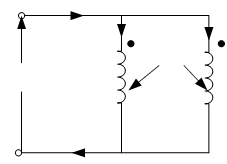Parallel Aiding:
Figure illustrates two coils coupled in parallel where the fluxes are additive as per dot convention.

Figure: Inductive Coupling in Parallel (Flux Aiding)
Using Kirchoff's voltage law, we may write
V = L1 (di1/ dt ) + M (di2/ dt)
Also,
V = L 2(di2/ dt ) + M (di1/ dt)
From Eqs. (2.42) and (2.43), we get
L (di1/ dt ) + M( di2/ dt) = L (di2/ dt ) + M( di1/ dt )
Now
∴ i = i1 + i2
i2 = i - i1
Substituting i2 from Eq. (45) in Eq. (44), we obtain
L1 (di1/ dt) + M d (i - i1 )/ dt = L2 d (i - i1 ) / dt + M (di1/ dt)
Or, L1 (di1/ dt) + M di / dt - M di1 / dt = L2 (di / dt) - L2 (di1 / dt )+ M (di1/ dt)
or, (L 1 + L2 - 2M ) (di1 /dt) = (L2 - M ) di1/dt
∴ di2/dt = ((L2 - M )/ (L1 + L2 - 2M )) di1/ dt
Similarly,
di2 /dt = ((L1 - M )/ L1 + L2 - 2M) di/dt
Using Eqs. (46) and (47) in Eq. (42), we get
V = L1 (L2 - M/ L1 + L2 - 2M) di/dt + M(L1 - M ) / (L1 + L2 - 2M ) (di/dt)
or, V = (L1 L2 - L 1M + L1 M - M 2) / (L1 + L2 - 2M) di/dt
or V = (L1 L2 - M2 )/ (L1 + L2 - 2M) di/dt
Let L be the equivalent inductance of the parallel combination, then we may write
V = L (di /dt)
From Eqs. (50) and (51), we obtain
L (di/dt ) = (L1 L2 - M2 )/ (L1 + L2 - 2M) di/dt
L = (L1 L2 - M2)/ (L1 + L2 - 2M)